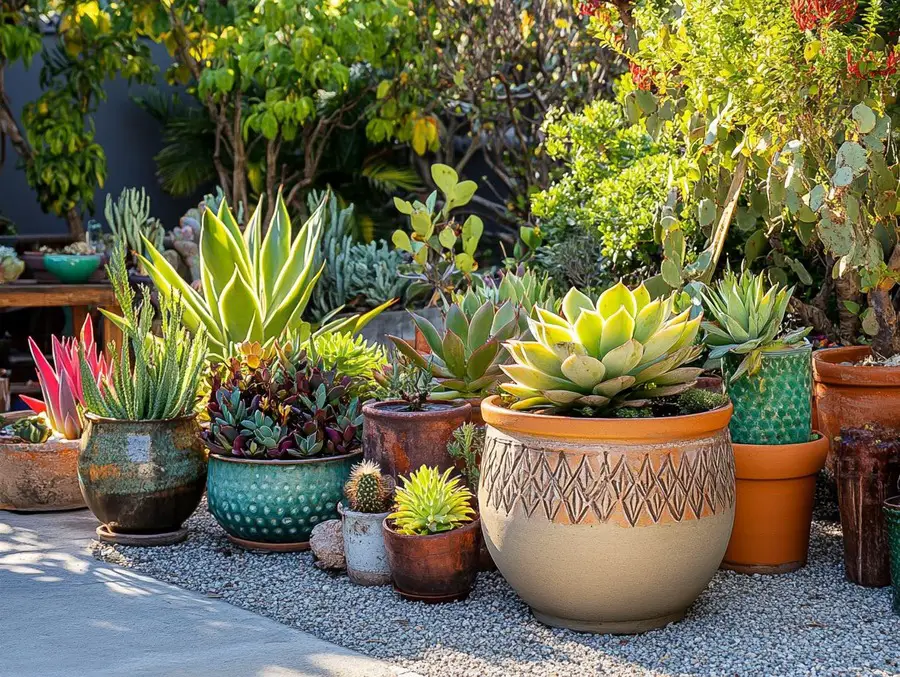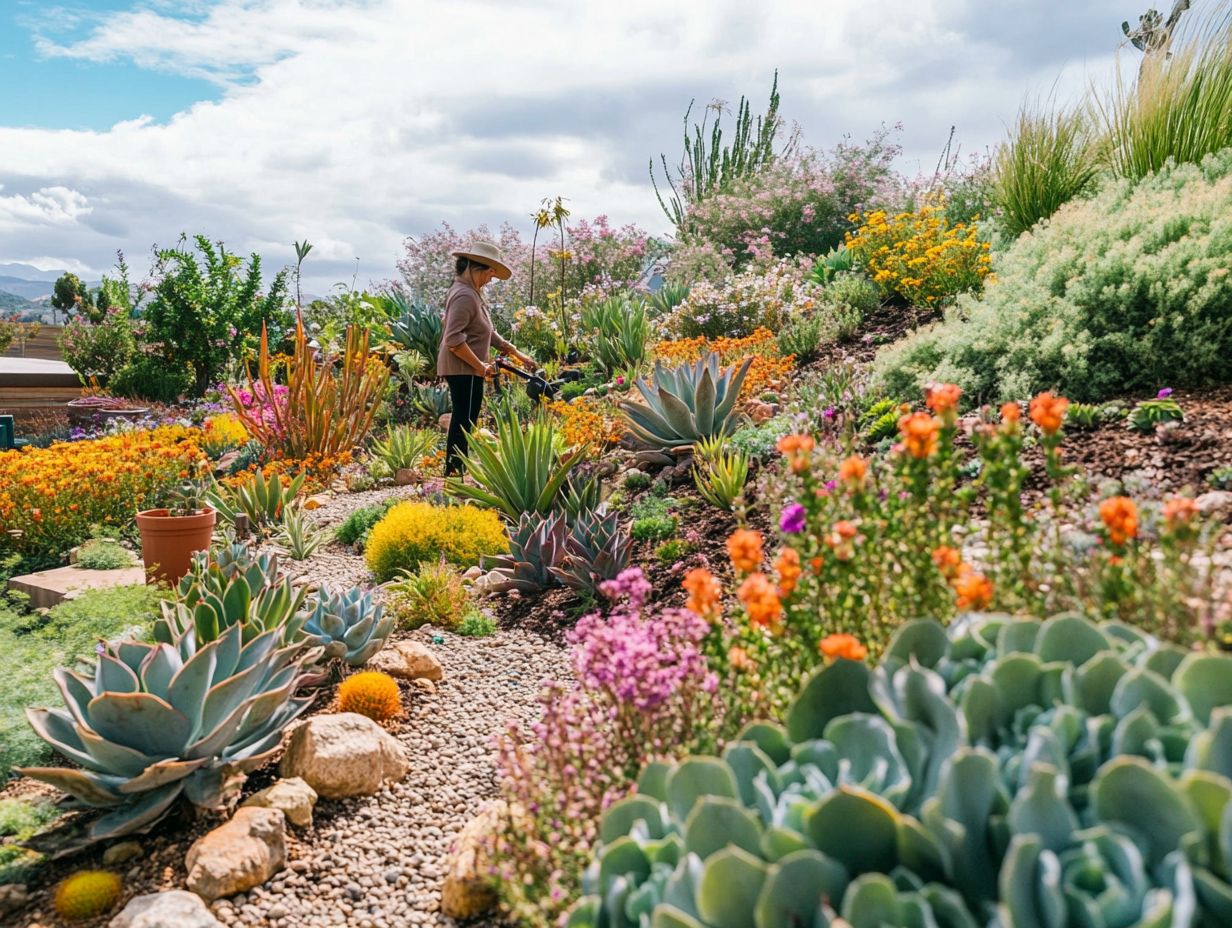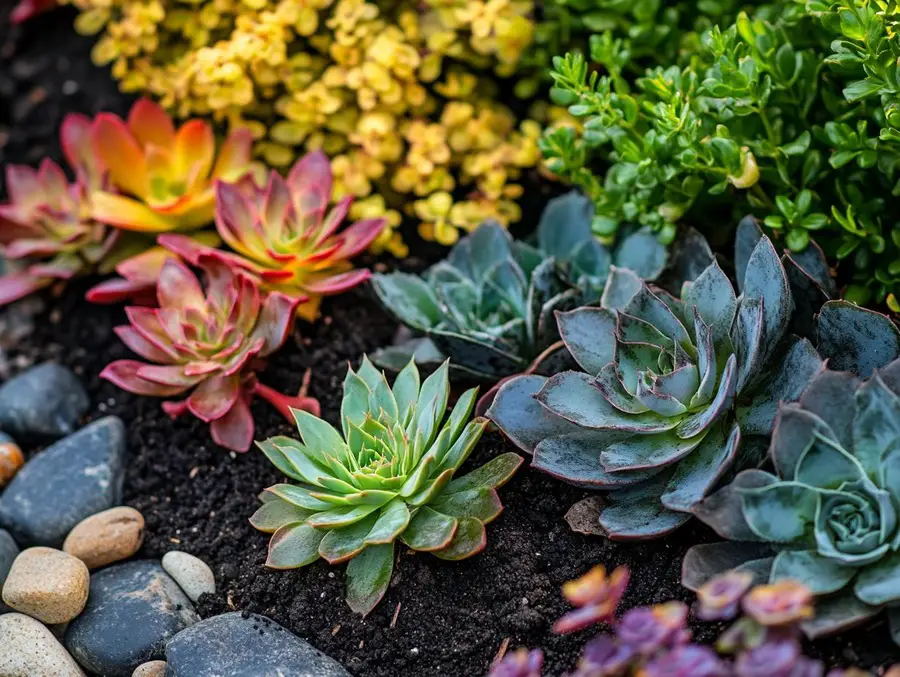We use affiliate links. If you purchase something using one of these links, we may receive compensation or commission.
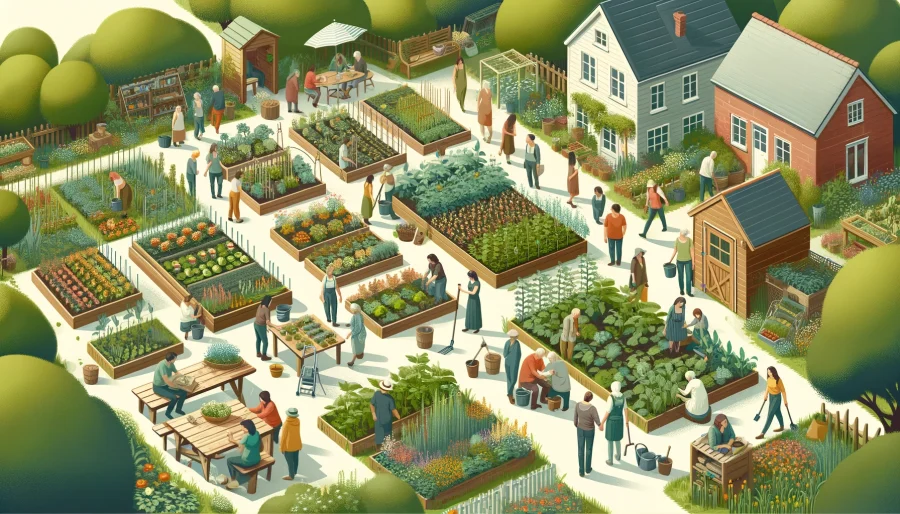
Curious about the magic of community gardens? Dive into the world of community gardens benefits, where neighbors come together to grow fresh produce, build friendships, and transform spaces into thriving green havens.
Let’s explore how these gardens make a big difference in our lives and communities!
Community Garden Benefits Key Takeaways
- Community Garden Benefits include providing fresh produce, improving mental and physical health, fostering community connections, and promoting sustainable practices.
- These gardens are a great way to bring people together and enhance local environments.
Community Gardens Benefits
Curious about how community gardens can change your neighborhood?
In this comprehensive blog post we will explore Community Gardens Benefits and how to start a community garden in your neighborhood
Dive into the many benefits of community gardens.
These green spaces bring folks together, grow fresh produce, and boost local health and happiness.
What is a Community Garden?
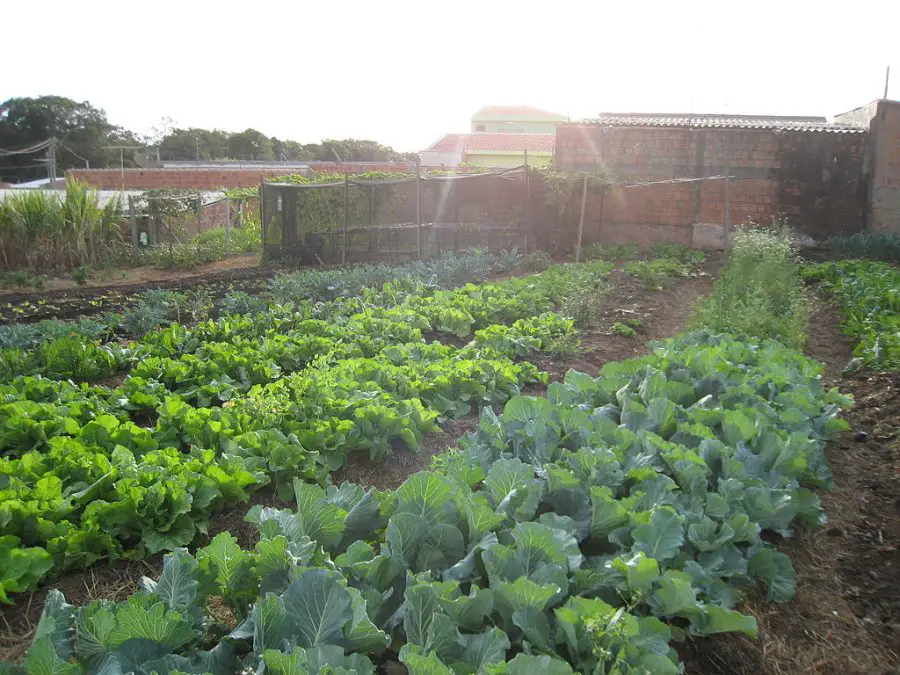
A community garden is a shared space where people come together to grow fruits, vegetables, and flowers.
It’s more than just a garden; it’s a place to connect with neighbors, learn new skills, and enjoy the outdoors.
Social Benefits
Building Friendships
Community gardens are fantastic for making new friends and strengthening ties with neighbors.
Working together on shared projects fosters a sense of community and cooperation.
Reducing Crime
Community gardens can help reduce crime rates by revitalizing neglected spaces and fostering a sense of pride and ownership among residents.
Health Benefits
Physical Health
Gardening is a great way to get some exercise. Digging, planting, and weeding all help keep you active and healthy.
Mental Health
Spending time in a garden can reduce stress and improve your mood. The peaceful environment and the act of nurturing plants are therapeutic.
Environmental Benefits
Sustainability
Community gardens promote sustainable practices like composting and water conservation.
They also help reduce the carbon footprint by providing local produce, which cuts down on food miles.
Biodiversity
These gardens support a variety of plants and wildlife, creating a small but vital ecosystem in urban areas.
Economic Benefits
Cost Savings
Growing your own fruits and vegetables can save you money on groceries.
It’s a great way to enjoy fresh, organic produce without breaking the bank.
Job Creation
Community gardens can create local job opportunities, from garden management to educational programs.
They also support local businesses by creating demand for gardening supplies and services.
Educational Benefits
Learning Opportunities
Community gardens are perfect for teaching kids and adults about nature, sustainability, and healthy eating.
Schools often partner with community gardens to provide hands-on learning experiences.
Skill Development
From gardening techniques to leadership and teamwork, community gardens offer a wealth of opportunities to develop valuable skills.
Summing Up
Community gardens bring a wealth of benefits, from improving health and the environment to building stronger, more connected communities.
Whether you’re looking to make new friends, learn something new, or just enjoy some fresh air, community gardens have something to offer everyone.
Starting a Community Garden

Ready to start your own community garden? Let’s walk through the steps to get your project off the ground and highlight why involving your community from the beginning is crucial for success.
Steps to Initiate a Community Garden Project
Gather Community Interest
Begin by gauging interest in your neighborhood. Host a meeting, create flyers, or use social media to spread the word.
The more people involved, the better the support and resources you’ll have.
Form a Planning Committee
Create a group of dedicated volunteers to help plan and manage the garden.
Assign roles such as project coordinator, treasurer, and communications officer to ensure tasks are well-organized.
Choose a Location
Find a suitable site for your garden. Look for unused plots of land, schoolyards, or parks.
Ensure the location gets plenty of sunlight, has access to water, and is convenient for the community.
Secure Funding
Identify potential sources of funding such as grants, donations, or local government support.
You can also organize fundraisers like plant sales or community events to raise money.
Design the Garden
Plan the layout of your garden. Decide on the size and number of plots, pathways, and any additional features like compost bins or seating areas.
Make sure to include space for tool storage and a water source.
Develop Rules and Guidelines
Establish clear rules and guidelines for garden members.
This includes plot assignments, maintenance responsibilities, and conflict resolution procedures.
A set of bylaws can help maintain order and ensure fairness.
Start Planting
Once everything is in place, gather your community for a planting day.
This is a great way to kick off the garden, build enthusiasm, and get everyone involved right from the start.
Importance of Community Involvement from the Start
Building Ownership
Involving the community from the beginning fosters a sense of ownership and responsibility.
When people feel invested, they are more likely to contribute their time and effort to keep the garden thriving.
Diverse Skills and Ideas
A community garden benefits from the diverse skills and ideas of its members.
Different perspectives can lead to innovative solutions and a more inclusive garden environment.
Strengthening Community Bonds
Working together on a shared project helps strengthen community bonds.
It creates a space for neighbors to meet, collaborate, and form lasting relationships.
Ensuring Sustainability
A garden that has strong community support is more likely to be sustainable in the long run.
When many hands share the workload, the garden can flourish even when individual members face challenges.
Starting a community garden is a rewarding endeavor that brings numerous benefits to both individuals and the community.
By following these steps and engaging your neighbors from the start, you can create a thriving garden that everyone can enjoy.
Organizing a Community Garden Group
Once you’ve decided to start a community garden, it’s time to organize a group to help make it happen.
Forming committees and recruiting volunteers are key steps to ensure everything runs smoothly.
Forming Committees and Establishing Roles
Committees
Creating committees helps distribute tasks and responsibilities, making the management of the garden more efficient.
Here are some essential committees you might consider:
1. Planning and Design Committee:
This group is responsible for creating the layout and design of the garden, ensuring it meets the needs of the community.
2. Fundraising Committee:
Handles securing funding through grants, donations, and fundraising events to support the garden’s expenses.
3. Maintenance Committee:
Ensures the garden is well-maintained, coordinates planting and harvesting schedules, and oversees regular upkeep.
4. Communications Committee:
Manages outreach efforts, keeps the community informed about garden activities, and handles publicity.
Roles
Assigning specific roles within these committees helps ensure clarity and accountability. Some key roles include:
Project Coordinator:
Oversees the entire project, ensuring all committees work together smoothly and goals are met.
Treasurer:
Manages the financial aspects, including budgeting, tracking expenses, and reporting on financial status.
Volunteer Coordinator:
Recruits, trains, and organizes volunteers, ensuring there are enough hands to help with various tasks.
Outreach Coordinator:
Handles communication with the community, local businesses, and media to promote the garden and its events.
Recruiting Volunteers and Promoting Participation
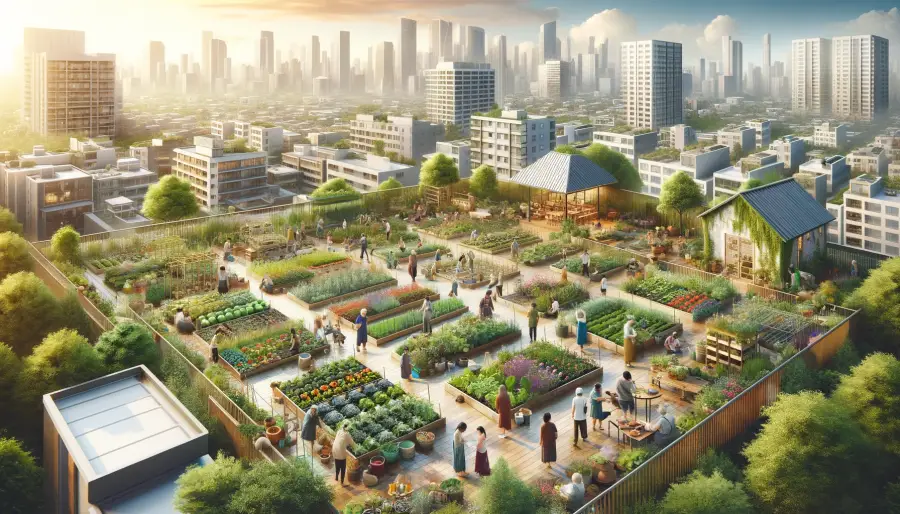
Recruitment Strategies
Community Meetings:
Host regular meetings to engage potential volunteers and keep current members informed and motivated.
Flyers and Posters:
Distribute flyers and posters in local libraries, community centers, schools, and businesses to attract interest.
Social Media:
Use social media platforms to reach a broader audience. Share updates, photos, and success stories to generate excitement.
Word of Mouth:
Encourage current members to spread the word among friends, family, and neighbors. Personal invitations can be very effective.
Promoting Participation
Inclusive Environment:
Create an inclusive environment where everyone feels welcome and valued. This can increase volunteer retention and participation.
Events and Workshops:
Organize gardening workshops, social events, and community activities to keep people engaged and involved.
Recognition:
Acknowledge and celebrate the contributions of volunteers. This can be through thank-you notes, social media shout-outs, or volunteer appreciation events.
Clear Communication:
Keep volunteers informed about upcoming events, tasks, and garden needs. Regular communication helps volunteers feel connected and valued.
Organizing a community garden group takes effort and dedication, but with the right committees, roles, and volunteers, your garden can thrive and become a cherished community space.
Choosing a Location for a Community Garden
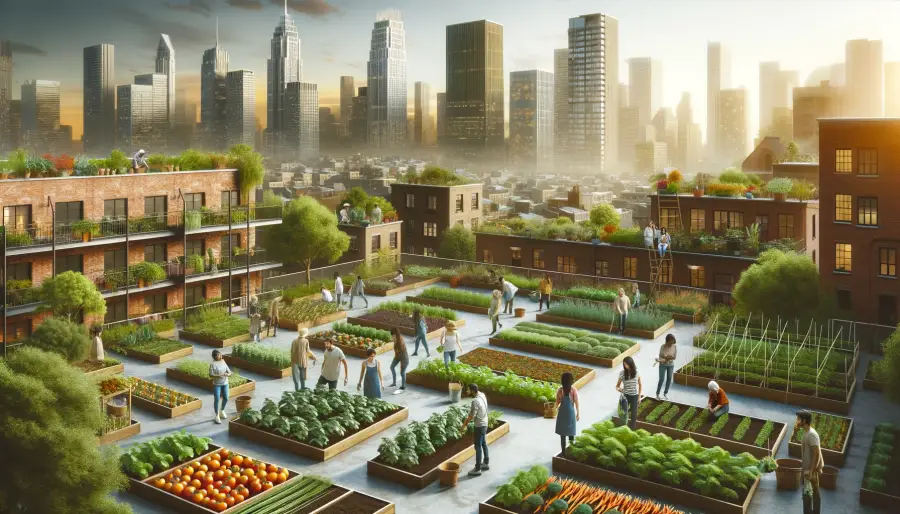
Picking the right spot for your community garden is key to its success. Let’s look at the best criteria for selecting a site and why accessibility and environmental factors matter.
Criteria for Selecting the Best Site
Sunlight
Your garden needs plenty of sunlight, ideally at least 6-8 hours of direct sunlight per day. This ensures your plants can grow strong and healthy.
Soil Quality
Good soil is essential for a thriving garden. Test the soil for nutrients and contaminants. If the soil quality is poor, you might need to use raised beds with imported soil.
Water Access
Having a reliable water source nearby is crucial. Ensure there’s easy access to water, either through a nearby tap or rainwater collection systems.
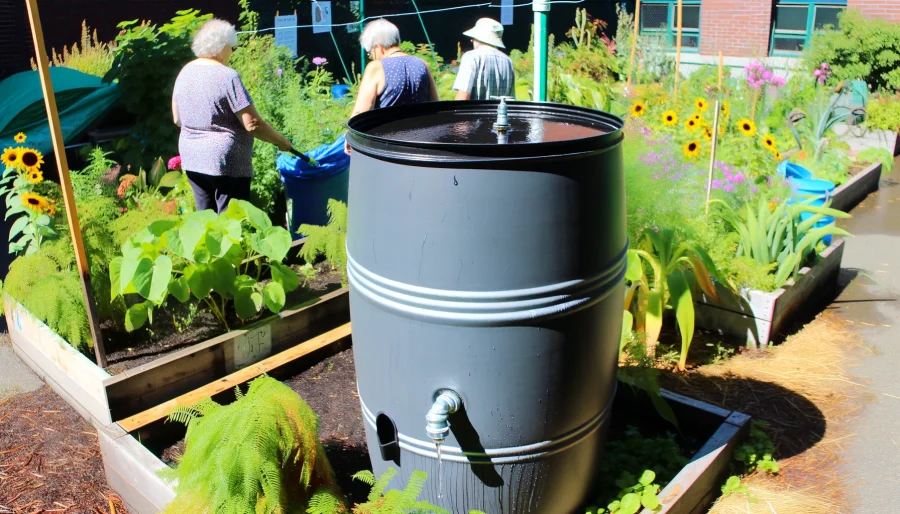
Size and Space
Consider the size of the area and how much space you’ll need for garden beds, pathways, and additional features like compost bins or tool sheds. Make sure there’s enough room to accommodate all your plans.
Security
Choose a site that is secure and safe. This could mean a location that is visible and frequented by the community to prevent vandalism and theft. Some gardens also benefit from fencing or secure gates.
Considering Accessibility and Environmental Factors
Accessibility
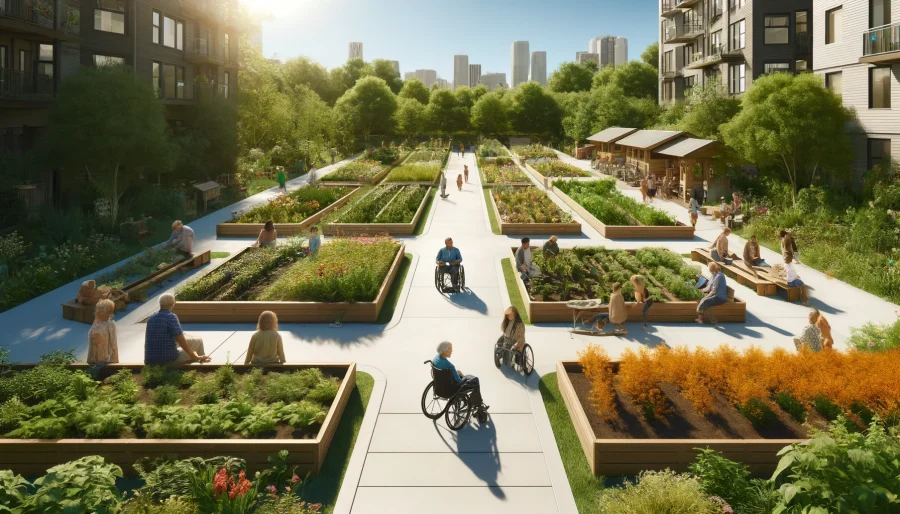
Ensure the garden is accessible to everyone, including people with disabilities.
This means having wide, clear paths for wheelchairs and easy-to-reach beds for those with mobility issues.
Proximity to the Community
The garden should be easily accessible to the community members who will use it.
A central location within the neighborhood can encourage more participation and frequent visits.
Environmental Impact
Consider the environmental impact of your garden.
Choose a site that won’t negatively affect local wildlife and can support sustainable gardening practices.
Avoid areas prone to flooding or heavy pollution.
Existing Infrastructure
Utilize existing infrastructure like fences, sheds, or water lines to save costs and reduce the need for additional construction.
Choosing the right location for your community garden sets the foundation for its success.
By considering sunlight, soil quality, water access, size, security, accessibility, and environmental impact, you can create a thriving space that benefits the entire community.
Community Garden Design Ideas

Designing a community garden is an exciting part of the process.
Let’s explore some layout planning and aesthetic tips to create a beautiful and functional garden, while also ensuring it’s accessible for everyone.
Layout Planning and Aesthetic Considerations
Garden Layout
Raised Beds and Rows:
Using raised beds can improve drainage and soil quality. Plan your garden with organized rows and beds to maximize space and make maintenance easier.
Paths and Walkways:
Include wide, clear paths between beds for easy access. Gravel, mulch, or stone paths are durable and low-maintenance options.
Zoning:
Divide your garden into zones for different activities, like planting, composting, and seating areas. This helps keep things organized and makes the space more user-friendly.
Water Features:
Incorporating a water feature like a small pond or fountain can enhance the garden’s aesthetic and provide a habitat for beneficial insects.
Aesthetic Considerations
Plant Variety:
Mix different types of plants, including flowers, vegetables, and herbs, to add visual interest and biodiversity. Consider color, texture, and height variations.
Art and Decorations:
Add artistic elements such as murals, sculptures, or painted rocks. These can make the garden more inviting and reflect the community’s personality.
Seating Areas:
Include benches or picnic tables where gardeners can rest, socialize, or enjoy the scenery. Placing these in shaded areas can offer a cool retreat during hot days.
Signage:
Use signs to label plant types, provide gardening tips, or share community messages. This adds an educational element and helps new gardeners learn.
Making the Garden Accessible for Individuals with Disabilities
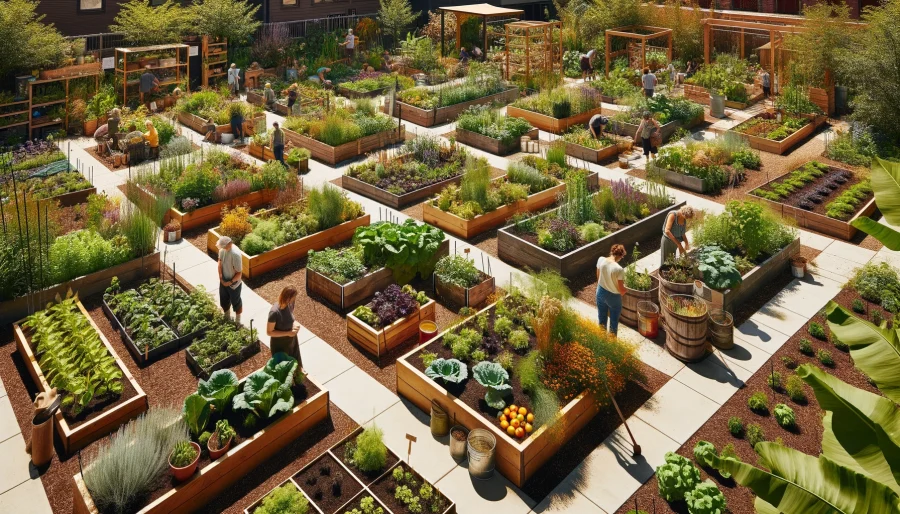
Raised Beds and Planters
Height:
Ensure some raised beds are at a height that is accessible for individuals in wheelchairs or those who have difficulty bending down.
Width:
Keep raised beds narrow enough to allow easy reach from either side, typically no wider than 4 feet.
Pathways
Surface:
Use smooth, non-slip materials for paths to ensure they are wheelchair-friendly. Avoid loose gravel or uneven stones.
Width:
Paths should be wide enough to accommodate wheelchairs, ideally at least 3 feet wide.
Tools and Facilities
Adaptive Tools:
Provide gardening tools designed for individuals with disabilities, such as long-handled tools or those with ergonomic grips.
Accessible Facilities:
Ensure there are accessible restroom facilities and shaded rest areas available for everyone.
Community Involvement
Inclusivity:
Involve individuals with disabilities in the planning process to ensure their needs are met.
This can lead to a more inclusive and supportive community garden environment.
Designing a community garden with thoughtful layout planning and aesthetic considerations can create a beautiful and functional space.
Ensuring accessibility for individuals with disabilities makes the garden welcoming and usable for everyone, fostering a truly inclusive community.
Funding for Community Gardens

Funding is essential to start and maintain a community garden.
Let’s explore various sources of funding, including grants, donations, and fundraisers, along with some creative fundraising ideas to keep your garden growing.
Sources of Funding
Grants
Government Grants:
Many local, state, and federal programs offer grants specifically for community development and green projects. Look into agricultural extensions, environmental agencies, and urban development programs.
Non-Profit Organizations:
Organizations like the National Gardening Association, American Community Gardening Association, and others provide grants for community gardens. Check their websites for application details and deadlines.
Corporate Grants:
Some companies offer community improvement grants as part of their corporate social responsibility programs. Reach out to local businesses and large corporations with a history of supporting community projects.
Donations
Local Businesses:
Local businesses often support community projects through donations of money, materials, or services. Approach garden centers, grocery stores, and other local businesses for support.
Community Members:
Engage the community by asking for individual donations.
This can be done through crowdfunding platforms, community events, or direct appeals to neighbors.
In-Kind Donations:
Seek donations of materials such as soil, plants, tools, and building supplies. Local nurseries, hardware stores, and landscapers might be willing to contribute.
Fundraisers
Plant Sales:
Host a plant sale featuring seedlings, herbs, and flowers grown by the community. This not only raises funds but also promotes gardening.
Workshops and Classes:
Offer gardening workshops or classes for a small fee. Topics can range from basic gardening techniques to advanced organic practices.
Events:
Organize events such as garden tours, harvest festivals, or community dinners. Charge an entry fee or suggest a donation to participate.
Creative Fundraising Ideas

Garden Art Auction
Encourage local artists to create garden-themed art pieces.
Host an auction where community members can bid on the artwork.
This can be a fun event that draws people together and raises funds.
Adopt-a-Plot Program
Allow individuals or businesses to “adopt” a plot in the garden for a donation.
In return, they get a plaque or sign recognizing their contribution and the opportunity to care for their plot.
Membership Program
Create a membership program where community members pay a small annual fee to support the garden.
Offer benefits like exclusive workshops, discounts on garden produce, or a member newsletter.
Community Cookbook
Collect favorite recipes from community members, especially those featuring garden produce, and compile them into a cookbook.
Sell the cookbook to raise funds for the garden.
Seasonal Markets
Host seasonal markets where garden produce, homemade crafts, and baked goods are sold.
These markets can attract visitors and generate income for the garden.
Securing funding for a community garden requires creativity and community involvement.
By exploring various sources of funding and implementing creative fundraising ideas, you can ensure your garden thrives and continues to benefit the community.
Legal Considerations for Community Gardens
Starting a community garden involves navigating local regulations and legal requirements.
Let’s break down what you need to know about obtaining permits, creating bylaws, and setting up a memorandum of understanding for members.
Understanding Local Regulations and Obtaining Necessary Permits
Local Regulations
Zoning Laws:
Check your local zoning laws to ensure that the land you want to use is designated for agricultural or recreational use.
Some areas might have restrictions on using vacant lots or public spaces for gardening.
Land Use Agreements:
If your group does not own the land, you’ll need a lease or land use agreement with the property owner.
This document should outline the terms of use, duration, and responsibilities of both parties.
Health and Safety Codes:
Adhere to local health and safety codes, which may include regulations on composting, use of pesticides, and water management.
Ensuring compliance can help avoid fines and keep the garden safe for all users.
Obtaining Permits
Building Permits:
If your garden plans include structures like sheds, greenhouses, or fences, you might need a building permit.
Check with your local building department for specific requirements.
Water Use Permits:
In some areas, you may need a permit for installing irrigation systems or using a significant amount of water.
Contact your local water authority to understand the regulations.
Environmental Permits:
If your garden involves any activities that could impact the environment, such as creating wetlands or altering drainage patterns, you may need environmental permits.
Creating Bylaws and a Memorandum of Understanding for Members
Bylaws
Purpose and Objectives:
Clearly define the purpose and objectives of your community garden.
This sets the foundation for all members and helps guide decision-making.
Membership Rules:
Outline who can join the garden, how members are selected, and any dues or fees associated with membership.
Specify the expectations for member participation and plot maintenance.
Governance Structure:
Describe the governance structure, including the roles and responsibilities of the board or committee members.
Define how decisions will be made and how meetings will be conducted.
Conflict Resolution:
Include a section on conflict resolution to address disputes among members. Having a clear process can help maintain harmony and keep the garden running smoothly.
Memorandum of Understanding (MOU)
Roles and Responsibilities:
The MOU should detail the roles and responsibilities of each member.
This includes plot maintenance, participation in group activities, and adherence to garden rules.
Use of Common Areas:
Specify how common areas such as pathways, tool sheds, and compost bins should be used and maintained.
This ensures that everyone understands their part in keeping these spaces functional and tidy.
Term and Termination:
Define the term of the agreement and the conditions under which it can be terminated.
This could include non-compliance with garden rules or voluntary withdrawal by a member.
Signatures:
Have all members sign the MOU to acknowledge their understanding and agreement to the terms.
This formalizes their commitment and helps prevent misunderstandings.
Understanding the legal aspects of starting a community garden is crucial for its success and sustainability.
By complying with local regulations, obtaining necessary permits, and establishing clear bylaws and agreements, you can create a well-organized and legally sound community garden.
Benefits of Community Gardens
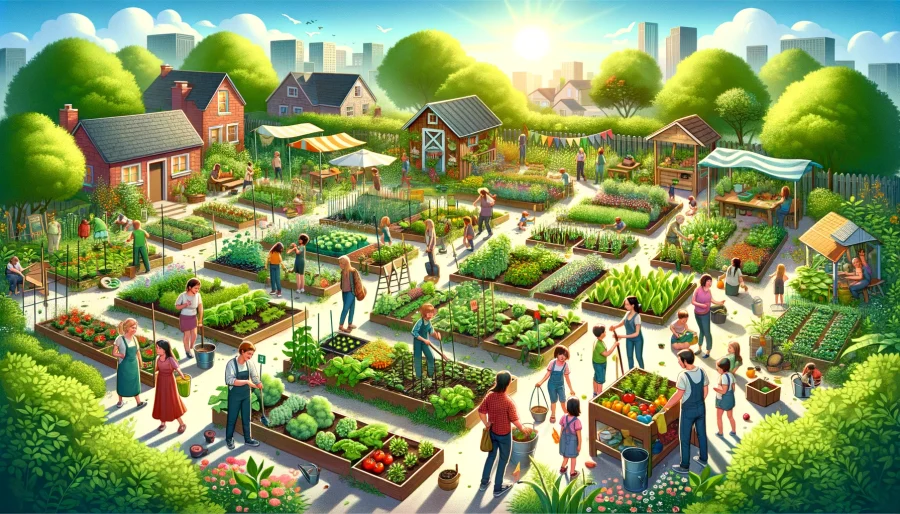
Community gardens do more than just provide fresh produce.
They offer a variety of social, environmental, economic, and educational benefits.
Let’s explore how these gardens can positively impact your community.
Social Benefits
Fostering Community Spirit
Community gardens bring people together. Neighbors who might not otherwise interact work side-by-side, building friendships and a sense of community.
These gardens become gathering places where people can share their love of gardening and work towards common goals.
Reducing Crime
By transforming vacant lots into vibrant gardens, community gardens can reduce crime in neighborhoods.
They provide a positive use for otherwise neglected spaces, which can deter criminal activity.
The presence of engaged community members further promotes safety and vigilance.
Environmental Benefits
Promoting Sustainability
Community gardens encourage sustainable practices such as composting, organic farming, and water conservation.
These practices help reduce waste, lower the use of harmful chemicals, and promote the health of the local ecosystem.
Enhancing Biodiversity

Gardens can serve as urban oases, supporting a variety of plants, insects, and wildlife.
They create green spaces in cities, contributing to local biodiversity and offering habitats for pollinators like bees and butterflies.
Community Gardens Benefits – Economic Benefits
Reducing Food Costs
Growing your own fruits and vegetables can significantly cut down on grocery bills.
Community gardens make fresh, healthy produce more accessible, especially in areas where it might otherwise be scarce or expensive.
Creating Local Jobs
Community gardens can create job opportunities, from managing the garden to running educational programs.
They also support local businesses by increasing the demand for gardening supplies and services.
Educational Benefits
Providing Hands-On Learning
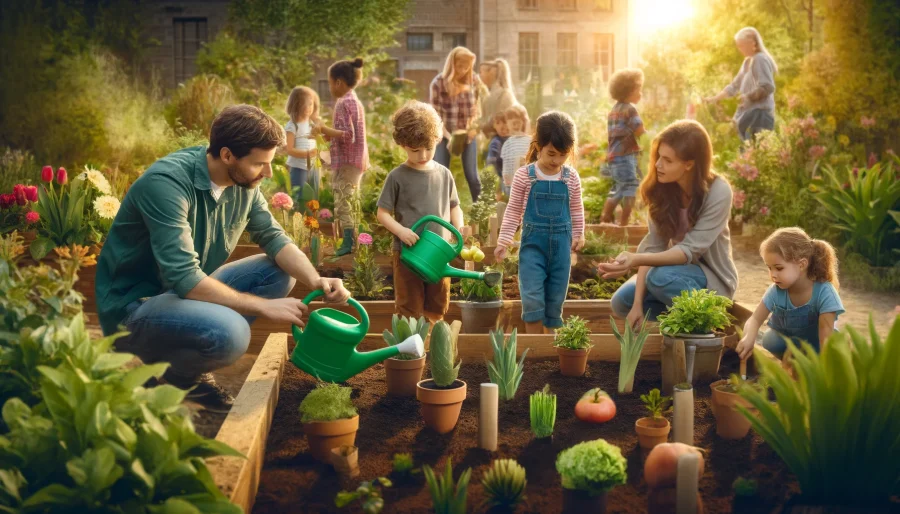
Community gardens are excellent educational tools.
They offer hands-on learning experiences for people of all ages, teaching gardening skills, environmental stewardship, and healthy eating habits.
Schools often collaborate with community gardens to enrich their curriculums.
Skill Development
Beyond gardening, participants can develop valuable skills such as teamwork, leadership, and project management.
These skills can be beneficial in many aspects of life and work.
Community gardens are much more than places to grow food.
They foster community spirit, enhance the environment, provide economic benefits, and offer educational opportunities.
By participating in a community garden, you can contribute to a healthier, more connected, and vibrant community.
Health Benefits of Community Gardening
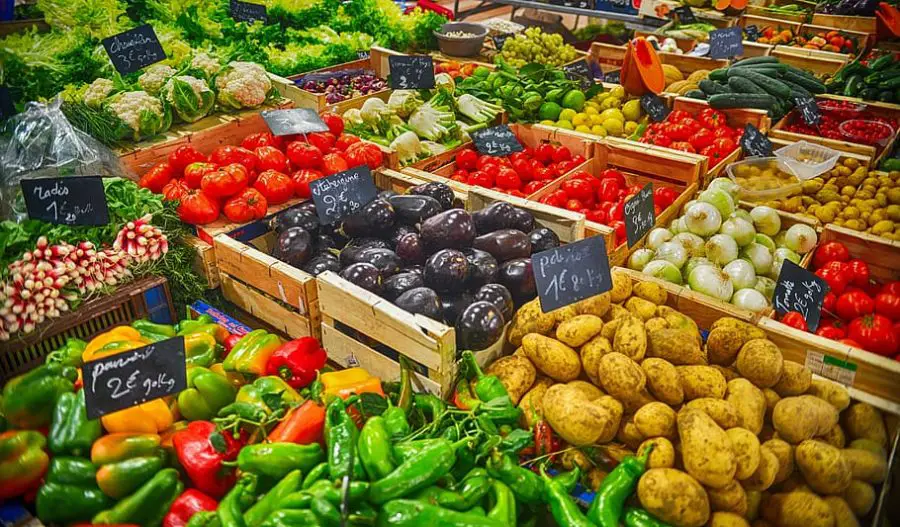
Community gardening isn’t just about growing plants; it’s also about improving your health.
Let’s dive into how gardening can benefit your physical and mental well-being.
Physical Health
Exercise
Gardening is a fantastic way to get physical exercise. Activities like digging, planting, weeding, and watering all contribute to a healthy, active lifestyle.
Regular gardening can improve your cardiovascular health, build muscle strength, and increase flexibility. It’s a great way to stay fit without needing a gym membership.
Improved Nutrition
Growing your own fruits and vegetables means you have easy access to fresh, nutritious produce.
Eating more home-grown fruits and veggies can lead to a healthier diet, packed with essential vitamins and minerals.
This can help prevent chronic diseases, boost your immune system, and improve overall health.
Mental Health
Stress Reduction
Gardening has been shown to reduce stress levels.
Spending time outdoors, working with plants, and connecting with nature can lower cortisol levels, the hormone associated with stress.
The rhythmic, repetitive nature of gardening tasks can also be meditative, helping you to unwind and relax.
Therapeutic Effects
Community gardening provides therapeutic benefits for mental health.
It can combat feelings of depression and anxiety by providing a sense of purpose and accomplishment.
The social aspect of gardening, such as interacting with neighbors and working together on common goals, can reduce feelings of loneliness and isolation.
Mindfulness and Relaxation
Gardening encourages mindfulness, allowing you to focus on the present moment.
This can improve mental clarity and emotional stability.
The sensory experience of touching soil, smelling flowers, and listening to birds can be incredibly soothing and grounding.
Community gardening offers numerous health benefits, making it a rewarding activity for people of all ages.
By engaging in gardening, you can improve your physical fitness, enjoy better nutrition, and enhance your mental well-being, all while connecting with your community and the natural world.
Best Plants for Community Gardens
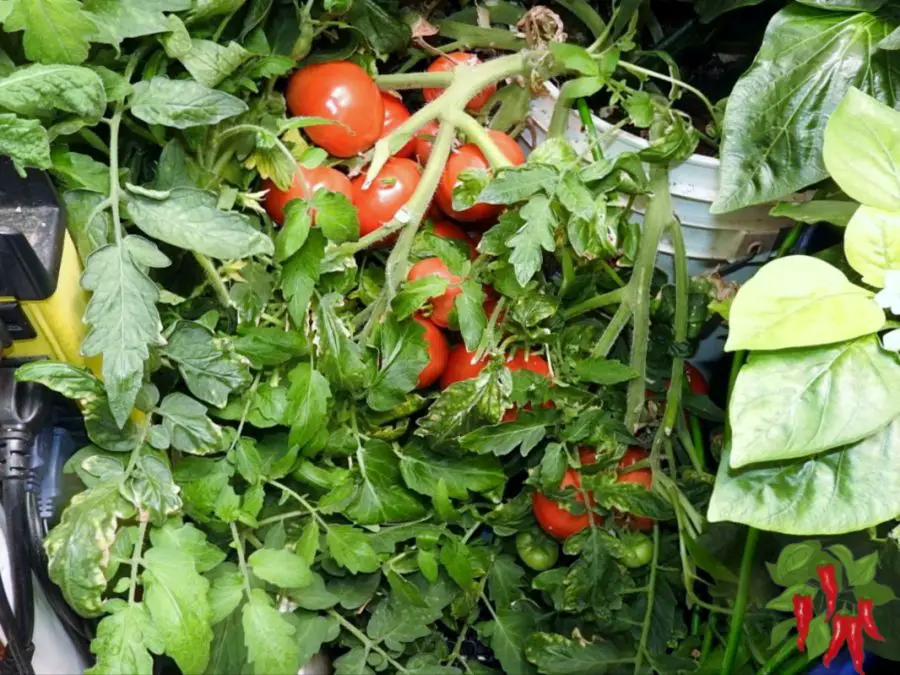
Choosing the right plants for your community garden is key to its success.
Let’s explore how to select plants suited to your climate and soil, and the benefits of companion planting to maximize your garden’s yield.
Selecting Plants Suited to Your Climate and Soil
Know Your Climate
Different plants thrive in different climates. It’s important to choose plants that are well-suited to the specific weather patterns and temperature ranges of your area.
Here’s a quick guide:
Warm Climates:
Tomatoes, peppers, eggplants, and melons thrive in warm, sunny conditions. These plants need a long growing season with plenty of sunlight.
Cool Climates:
Leafy greens like spinach, kale, and lettuce do well in cooler temperatures.
Root vegetables such as carrots, radishes, and beets are also good choices for cooler climates.
Moderate Climates:
In areas with mild weather, you can grow a wide variety of vegetables, including beans, peas, and squashes. These plants are versatile and adapt well to different conditions.
Soil Considerations
Understanding your soil type is crucial for plant health. Perform a soil test to determine its pH and nutrient levels. Here are some tips based on soil types:
Sandy Soil:
Well-drained but low in nutrients. Add organic matter like compost to improve fertility.
Plants that thrive include carrots, radishes, and potatoes.
Clay Soil:
Nutrient-rich but poorly drained. Improve texture and drainage by adding compost and sand.
Suitable plants include beans, cabbages, and broccoli.
Loamy Soil:
Ideal for most plants as it retains moisture and nutrients well while allowing for good drainage.
Almost any vegetable can thrive in loamy soil.
Companion Planting and Maximizing Yield
Companion Planting Basics
Companion planting involves growing certain plants together to enhance growth, deter pests, and improve yields. Here are some classic pairings:
Tomatoes and Basil:
Basil helps repel pests that target tomatoes, and its presence can enhance the flavor of the tomatoes.
Carrots and Onions:
Onions can help deter carrot flies, while carrots benefit from the natural pest protection provided by onions.
Corn, Beans, and Squash (Three Sisters):
Corn provides support for beans to climb, beans fix nitrogen in the soil, and squash covers the ground to suppress weeds and retain moisture.
Maximizing Yield
To get the most out of your community garden, consider these strategies:
Succession Planting:
Plant fast-growing crops like lettuce or radishes in the same space where slower-growing crops like tomatoes or peppers will later mature.
This ensures continuous production throughout the growing season.
Vertical Gardening:
Use trellises, stakes, or cages to grow plants vertically.
This saves space and allows for better air circulation, reducing disease risk.
Intercropping:
Plant different crops in the same area to maximize space and improve soil health.
For example, plant lettuce between rows of taller plants like corn or tomatoes.
Soil Enrichment:
Regularly add compost and organic matter to keep the soil fertile.
Healthy soil leads to healthier plants and higher yields.
Selecting the right plants and using companion planting techniques can greatly enhance the productivity and health of your community garden.
By understanding your climate and soil, and employing smart gardening strategies, you can ensure a bountiful harvest and a thriving garden community.
Sustainable Practices in Community Gardens
Sustainability is at the heart of community gardening. Let’s dive into some organic gardening techniques and how composting and water conservation can make your garden more eco-friendly.
Organic Gardening Techniques

Avoiding Synthetic Chemicals
One of the key principles of organic gardening is avoiding synthetic fertilizers and pesticides. Instead, use natural alternatives:
Natural Fertilizers:
Compost, manure, and bone meal can provide essential nutrients to your plants without harming the environment.
These organic materials enrich the soil and promote healthy plant growth.
Pest Control:
Encourage beneficial insects like ladybugs and lacewings to keep harmful pests in check.
You can also use natural repellents like neem oil or insecticidal soap.
Planting flowers such as marigolds can deter pests and attract pollinators.
Crop Rotation
Rotate crops each season to prevent soil depletion and reduce the risk of disease.
Different plants have different nutrient needs, and rotating them helps maintain soil health and fertility.
For example, follow nitrogen-fixing plants like beans with nitrogen-hungry crops like corn.
Mulching
Mulching involves covering the soil with organic materials like straw, leaves, or grass clippings.
Mulch helps retain soil moisture, suppress weeds, and improve soil structure as it decomposes.
It also provides a habitat for beneficial organisms that contribute to soil health.
Composting and Water Conservation
Composting
Composting is a great way to recycle organic waste and create nutrient-rich soil for your garden:
Starting a Compost Pile:
Collect kitchen scraps (like fruit and vegetable peels), yard waste (like leaves and grass clippings), and other organic materials.
Avoid meat, dairy, and oily foods which can attract pests.
Balance green (nitrogen-rich) and brown (carbon-rich) materials for optimal decomposition.
Maintaining the Pile:
Turn the compost regularly to aerate it and speed up the decomposition process.
Keep the pile moist, but not too wet, to maintain microbial activity.
Finished compost should be dark, crumbly, and have an earthy smell.
Water Conservation
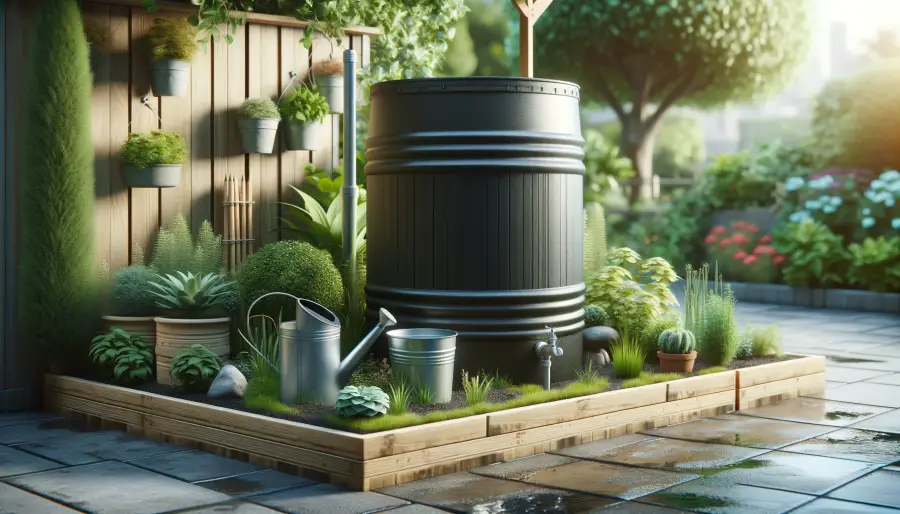
Water is a precious resource, and conserving it is essential for sustainable gardening:
Rainwater Harvesting:
Collect rainwater using barrels or other containers. This reduces your reliance on tap water and provides your garden with a natural, untreated water source.
Drip Irrigation:
Drip irrigation systems deliver water directly to the plant roots, minimizing evaporation and runoff.
They are highly efficient and can be set on timers to ensure plants receive consistent moisture.
Mulching:
As mentioned earlier, mulch helps retain soil moisture by reducing evaporation. It also keeps the soil cooler, reducing the need for frequent watering.
Watering Techniques:
Water plants early in the morning or late in the evening to reduce evaporation.
Use a watering can or hose with a spray nozzle to target the base of plants, ensuring water reaches the roots where it’s needed most.
By incorporating these organic gardening techniques, composting, and water conservation practices, you can create a sustainable community garden that supports healthy plants, conserves resources, and benefits the environment.
These practices not only improve the garden’s productivity but also promote a greener, healthier community.
Community Garden Maintenance Tips
Keeping a community garden thriving requires regular maintenance and seasonal care.
Let’s explore some essential tasks to keep your garden healthy and productive throughout the year.
Regular Tasks to Keep the Garden Thriving
Watering
Regular watering is crucial for plant health. Make sure plants receive consistent moisture, especially during dry periods.
Drip irrigation systems or soaker hoses can help deliver water directly to the roots, reducing waste and ensuring efficient use.
Weeding
Weeds compete with your plants for nutrients, water, and light.
Regular weeding helps maintain a clean garden and ensures your plants have the resources they need to thrive.
Mulching can also help suppress weed growth.
Pruning
Prune plants to remove dead or diseased branches and to encourage healthy growth.
Regular pruning can improve air circulation and sunlight penetration, reducing the risk of disease.
Pest and Disease Control
Regularly inspect plants for signs of pests and diseases.
Use organic methods like neem oil, insecticidal soap, or introducing beneficial insects to manage pests.
Remove and destroy any diseased plants to prevent the spread of pathogens.
Fertilizing
Regularly feed your plants with organic fertilizers like compost, manure, or commercial organic blends.
This ensures they receive essential nutrients for growth and production.
Seasonal Care and Preparation
Spring
Soil Preparation:
Before planting, prepare the soil by adding compost or organic matter. This improves soil structure and fertility, providing a good start for your plants.
Planting:
Spring is the time to plant most seeds and seedlings. Follow planting schedules for your region to ensure the best results.
Frost Protection:
Be prepared for late frosts. Use row covers or cloches to protect young plants from unexpected cold snaps.
Summer
Water Management:
As temperatures rise, ensure your garden is adequately watered. Deep watering in the early morning or late evening is most effective.
Mulching:
Apply a thick layer of mulch to conserve soil moisture and keep roots cool. This also helps control weeds.
Pest Control:
Summer pests can be more active. Regularly check for signs of infestations and address them promptly with organic treatments.
Fall
Harvesting:
Harvest crops as they mature. This encourages continued production and ensures you enjoy fresh produce.
Soil Testing:
Test your soil to determine nutrient levels. This helps you understand what amendments may be needed for the next growing season.
Cover Crops:
Plant cover crops like clover or rye to protect and enrich the soil over winter. These crops add organic matter and prevent soil erosion.
Winter
Tool Maintenance:
Clean and repair garden tools. Sharpen blades and oil moving parts to ensure they are ready for use in the spring.
Planning:
Use the winter downtime to plan next year’s garden. Review what worked well and what didn’t, and make adjustments to your garden plan.
Protection:
Protect any remaining plants from extreme cold with row covers or cloches.
Clear out any dead plants and debris to prevent overwintering pests and diseases.
Regular maintenance and seasonal care are essential for a thriving community garden.
By staying on top of these tasks, you can ensure a productive and healthy garden that benefits everyone involved.
Managing Pests in Community Gardens
Keeping pests at bay in your community garden is crucial for healthy plants.
Let’s explore integrated pest management strategies and organic, eco-friendly methods to control pests.
Integrated Pest Management (IPM) Strategies
Monitoring and Identification
Regularly check your plants for signs of pests. Early detection is key to managing infestations before they get out of control. Look for damaged leaves, holes, or insects on the plants.
Cultural Controls
Crop Rotation:
Rotate crops each season to prevent pests from establishing themselves in the soil. Different pests target different plants, so rotating helps break the pest cycle.
Sanitation:
Keep the garden clean by removing plant debris, fallen fruit, and weeds, which can harbor pests. Regularly clean tools and equipment to prevent the spread of pests and diseases.
Healthy Soil:
Maintain healthy soil through proper fertilization and pH balance. Healthy plants are more resistant to pests and diseases.
Physical Controls
Barriers:
Use row covers, netting, or plant collars to protect plants from pests. These physical barriers can prevent insects from reaching the plants.
Handpicking:
Manually remove larger pests like caterpillars, beetles, and slugs. This method is labor-intensive but effective for small infestations.
Biological Controls
Beneficial Insects:
Introduce beneficial insects like ladybugs, lacewings, and predatory wasps to control pest populations naturally. These insects prey on common garden pests.
Nematodes:
Use beneficial nematodes to target soil-dwelling pests. These microscopic worms can help control grubs, root maggots, and other harmful insects.
Organic and Eco-Friendly Pest Control Methods
Natural Sprays
Neem Oil:
Neem oil is effective against a wide range of pests, including aphids, mites, and whiteflies.
It disrupts the life cycle of insects, preventing them from feeding and reproducing.
Insecticidal Soap:
Insecticidal soaps are made from potassium salts of fatty acids and can control soft-bodied pests like aphids, mealybugs, and spider mites. Spray directly on the insects to eliminate them.
Garlic and Chili Spray:
A homemade garlic and chili spray can repel many insects.
Blend garlic and chili peppers with water, strain the mixture, and spray it on affected plants.
Companion Planting
Marigolds:
Planting marigolds around your garden can repel nematodes and other pests. Their strong scent deters many harmful insects.
Basil and Tomatoes:
Basil repels flies and mosquitoes, making it a great companion for tomatoes. It can also enhance the flavor of tomatoes.
Trap Crops
Nasturtiums:
Planting nasturtiums can attract pests away from your main crops. Pests like aphids and caterpillars prefer nasturtiums, keeping them off your valuable plants.
Radishes:
Radishes can be used as trap crops for flea beetles. Plant them around your garden to draw these pests away from other vegetables.
Soil Amendments
Diatomaceous Earth:
Sprinkle diatomaceous earth around plants to deter slugs, snails, and other crawling insects. It works by dehydrating and killing the pests.
Compost Tea:
Spray compost tea on plants to improve their health and resilience. Healthy plants are less attractive to pests and can better withstand infestations.
Using integrated pest management strategies and organic methods can help you effectively manage pests in your community garden.
These practices promote a healthy, eco-friendly environment, ensuring your garden thrives without harmful chemicals.
Tools and Equipment for Community Gardens
Having the right tools and equipment is essential for maintaining a successful community garden.
Let’s explore the must-have tools and some tips on maintaining and storing them properly.
Essential Tools and Their Uses
Hand Tools
Trowels:
Used for digging small holes, transplanting seedlings, and planting bulbs. A good trowel is a versatile tool for many gardening tasks.
Hand Forks:
Great for loosening soil, weeding, and aerating around plants. They are particularly useful in small or tight spaces.
Pruners:
Essential for trimming and shaping plants, removing dead or diseased growth, and harvesting fruits and vegetables. Look for sharp, durable pruners for clean cuts.
Weeders:
Designed to remove weeds from the root, these tools help keep your garden beds weed-free without disturbing the surrounding plants.
Larger Tools
Shovels and Spades:
Used for digging, moving soil, and planting larger plants.
A shovel with a rounded blade is ideal for digging, while a spade with a flat blade is great for edging and moving soil.
Garden Forks:
Perfect for turning compost, breaking up soil, and incorporating organic matter. Garden forks are essential for soil preparation and maintenance.
Rakes:
Useful for leveling soil, removing debris, and spreading mulch. Leaf rakes are great for clearing leaves and light materials, while garden rakes are better for soil work.
Hoes:
Used for cultivating soil and removing weeds. There are different types of hoes for various tasks, such as scuffle hoes for slicing weeds below the surface and draw hoes for breaking up soil.
Watering Equipment
Watering Cans:
Ideal for hand-watering delicate plants and seedlings. Look for a can with a detachable rose (sprinkler head) for versatility.
Hoses and Sprinklers:
Essential for watering larger areas. Invest in a durable hose and adjustable sprinklers to ensure even coverage.
Drip Irrigation Systems:
Highly efficient for water conservation, these systems deliver water directly to the plant roots, reducing evaporation and runoff.
Miscellaneous Tools
Wheelbarrows and Garden Carts:
Helpful for transporting soil, compost, plants, and tools around the garden. Choose a sturdy, easy-to-maneuver model.
Compost Bins:
Used for recycling organic waste into valuable compost. A well-managed compost bin can provide rich soil amendments for your garden.
Protective Gear:
Gloves, knee pads, and hats are essential for protecting yourself while working in the garden.
Look for durable, comfortable gear to make your gardening tasks safer and more enjoyable.
Tips for Maintaining and Storing Equipment
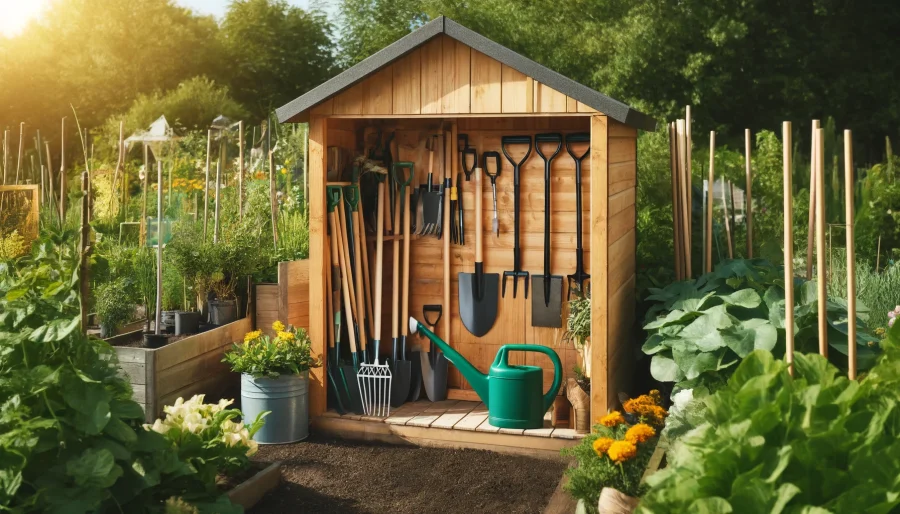
Cleaning
Regular Cleaning:
Clean tools after each use to remove soil, sap, and debris.
This helps prevent rust and keeps tools in good working condition.
Use a wire brush or putty knife to scrape off dirt and a damp cloth to wipe them down.
Disinfecting:
Disinfect tools, especially pruners, to prevent the spread of disease between plants. Use a solution of one part bleach to nine parts water or rubbing alcohol to wipe down blades and handles.
Sharpening and Oiling
Sharpen Blades:
Keep pruners, hoes, and other cutting tools sharp. Use a sharpening stone or file to maintain a keen edge.
Sharp tools make cleaner cuts, reducing plant stress and making your work easier.
Oil Moving Parts:
Oil hinges, blades, and other moving parts to prevent rust and ensure smooth operation. Use a light machine oil or specialized garden tool oil.
Storage
Dry Storage:
Store tools in a dry place to prevent rust. Hang tools on hooks or pegboards to keep them off the ground and organized.
Tool Maintenance Station:
Set up a dedicated area for tool maintenance. Keep cleaning brushes, sharpening stones, oil, and other supplies handy for regular upkeep.
Seasonal Care:
Before winter, clean and oil tools thoroughly. Store them in a dry, sheltered place.
For hoses, drain and coil them to prevent damage from freezing temperatures.
Having the right tools and maintaining them properly ensures that your community garden remains productive and enjoyable.
Regular care and proper storage extend the life of your equipment, making your gardening tasks easier and more efficient.
Involving Schools in Community Gardening
Bringing schools into the community garden is a fantastic way to educate and inspire the next generation.
Let’s look at how to create educational programs and partnerships with local schools, and the benefits of getting students involved in gardening activities.
Educational Programs and Partnerships with Local Schools
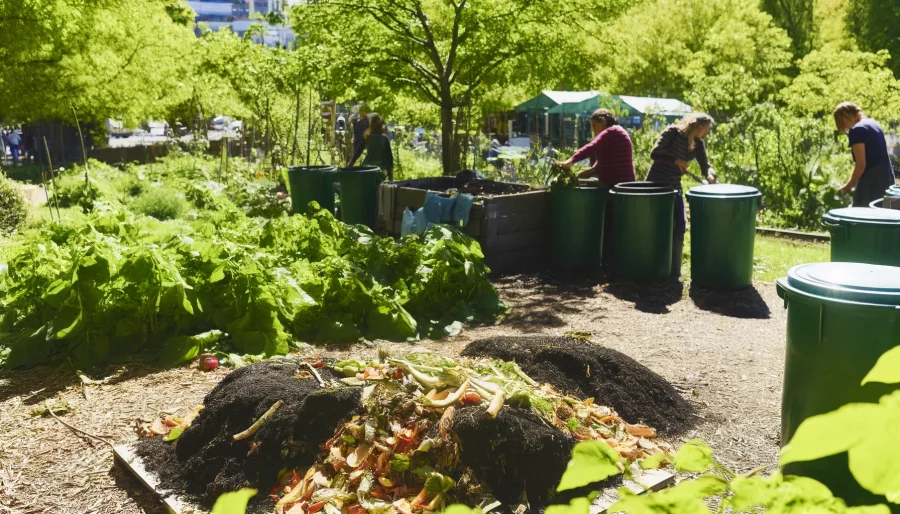
Setting Up Educational Programs
Garden Classes:
Organize regular garden classes where students can learn about plant biology, ecology, and sustainable practices.
These classes can be integrated into the school curriculum or offered as extracurricular activities.
Workshops:
Host workshops on topics like composting, planting techniques, and garden maintenance.
These hands-on sessions can teach students valuable skills and encourage a deeper understanding of environmental stewardship.
Seasonal Activities:
Plan seasonal activities such as planting in the spring, maintaining the garden in the summer, harvesting in the fall, and preparing the garden for winter.
These activities can help students understand the cycles of nature and the importance of year-round care.
Creating Partnerships
Collaboration with Teachers:
Work with teachers to align garden activities with educational standards and classroom topics.
This can enhance learning by providing practical, real-world applications of classroom lessons.
Parent and Community Volunteers:
Involve parents and community members in the garden program.
Their participation can provide additional support and resources, making the garden a true community effort.
Local Organizations:
Partner with local agricultural extensions, garden clubs, or environmental organizations.
These partnerships can bring additional expertise, resources, and funding to your garden program.
Benefits of Engaging Students in Gardening Activities
Hands-On Learning
Practical Skills:
Gardening teaches students practical skills such as planting, watering, weeding, and harvesting. These hands-on activities help students learn through experience and develop a sense of responsibility.
Science and Math Applications:
Gardening provides real-world applications for science and math concepts. Students can learn about plant biology, ecosystems, weather patterns, and measurement through garden activities.
Health and Nutrition
Healthy Eating:
Gardening encourages students to eat more fruits and vegetables.
When students grow their own food, they are more likely to try new foods and develop healthier eating habits.
Physical Activity:
Gardening is a great way for students to get physical exercise.
Tasks like digging, planting, and weeding help students stay active and develop fine and gross motor skills.
Social and Emotional Benefits
Teamwork and Cooperation:
Working in a garden teaches students to collaborate and work as a team.
These experiences can improve social skills, build friendships, and foster a sense of community.
Mental Well-being:
Spending time in nature and engaging in gardening activities can reduce stress and improve mental health.
The peaceful environment of a garden can provide a therapeutic space for students.
Environmental Awareness
Sustainability Practices:
Gardening teaches students about sustainable practices such as composting, water conservation, and organic farming.
These lessons can instill a lifelong appreciation for the environment and encourage eco-friendly behaviors.
Connection to Nature:
Engaging with a garden helps students develop a connection to nature.
This can foster a sense of wonder and respect for the natural world, encouraging stewardship and conservation efforts.
Involving schools in community gardening offers numerous benefits.
Educational programs and partnerships can enhance learning, promote healthy lifestyles, and foster environmental awareness.
By engaging students in gardening activities, we can inspire the next generation to care for their communities and the planet.
Community Garden Activities for Kids
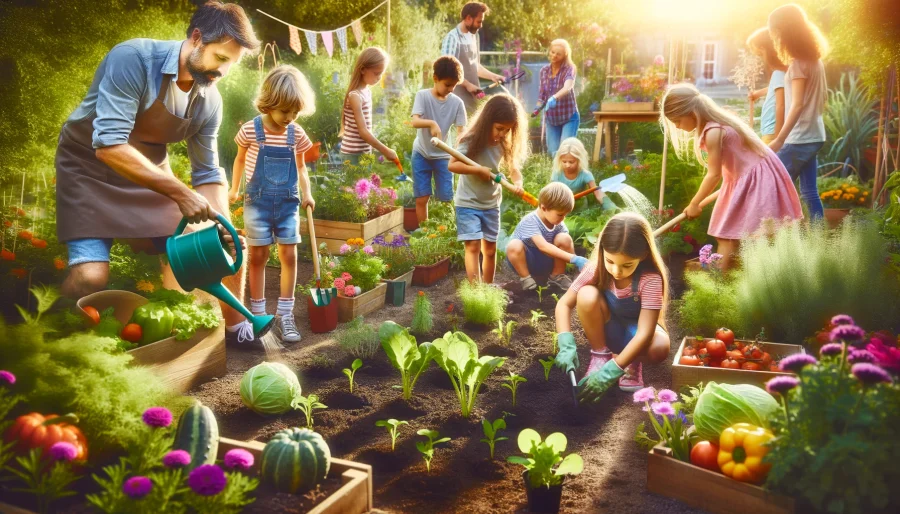
Getting kids involved in community gardening is both fun and educational.
Let’s explore some engaging gardening projects for children and ways to encourage their participation and learning.
Fun and Educational Gardening Projects for Children
Planting Seeds
Seed Starting:
Let kids start their own plants from seeds. Provide a variety of seeds like sunflowers, beans, or herbs.
Teach them how to plant seeds in small pots or seed trays and watch them sprout.
This project helps kids understand the life cycle of plants.
Garden Markers:
Have kids create colorful garden markers using craft supplies.
They can paint rocks, sticks, or recycled materials to label different plants.
This adds a personal touch to the garden and helps kids learn plant names.
Building Mini Gardens
Container Gardens:
Set up container gardens for kids to manage. Use pots, old buckets, or recycled containers.
Allow them to choose their plants, whether flowers, vegetables, or herbs, and take care of their mini garden.
Fairy Gardens:
Create fairy gardens with small plants, miniature decorations, and fairy figurines.
This imaginative project combines gardening with creativity, making it an exciting activity for kids.
Educational Projects
Composting:
Teach kids about composting by setting up a small compost bin.
Show them how to add kitchen scraps, yard waste, and how to turn the compost.
This project helps kids learn about recycling organic waste and the importance of soil health.
Bug Hotel:
Build a bug hotel using natural materials like twigs, pine cones, and leaves.
Place it in the garden to attract beneficial insects. Kids can learn about different insects and their roles in the ecosystem.
Seasonal Activities
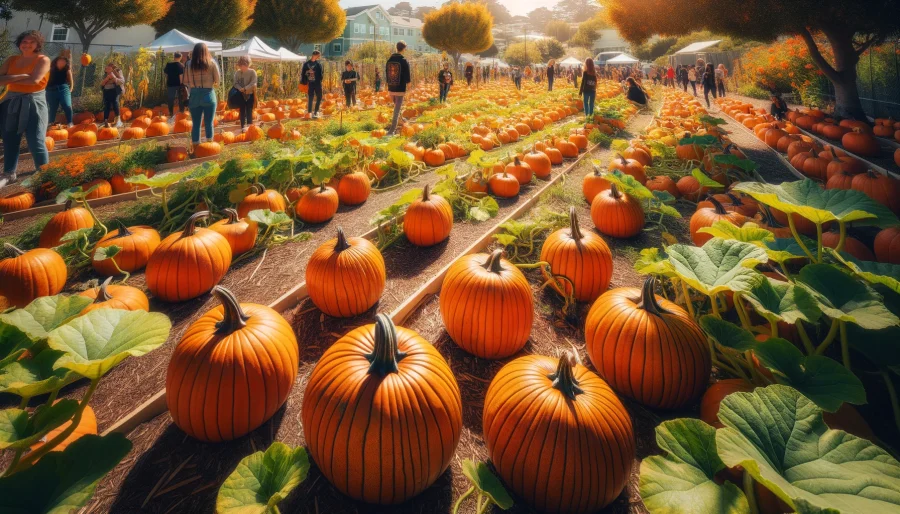
Pumpkin Patch:
Plant pumpkins in the spring and watch them grow throughout the summer.
In the fall, have a pumpkin harvest event where kids can pick their own pumpkins.
This seasonal project is fun and teaches patience and care.
Butterfly Garden:
Create a butterfly garden with nectar-rich flowers like milkweed, marigolds, and lavender.
Kids can learn about the life cycle of butterflies and enjoy watching them visit the garden.
Encouraging Youth Participation and Learning
Hands-On Involvement
Interactive Workshops:
Host workshops where kids can get their hands dirty and learn about gardening topics.
These can include planting techniques, soil health, and eco-friendly gardening practices.
Garden Clubs:
Start a garden club for kids where they can regularly participate in gardening activities, share their experiences, and learn from each other.
This creates a sense of community and continuous learning.
Making Gardening Fun
Games and Challenges:
Incorporate games and challenges into gardening tasks.
For example, have a race to see who can plant the most seeds or a scavenger hunt to find different types of plants and insects.
Rewards and Recognition:
Recognize kids’ efforts with rewards like stickers, certificates, or small garden-themed prizes.
Celebrating their contributions encourages ongoing participation and enthusiasm.
Learning Opportunities
Nature Journals:
Encourage kids to keep a nature journal where they can draw plants, record observations, and write about their gardening experiences.
This combines art, science, and writing skills.
Field Trips:
Organize field trips to local farms, botanical gardens, or nature reserves. These trips can expand kids’ understanding of gardening and the natural world.
Engaging Families
Family Gardening Days:
Host family gardening days where parents and children can work together on garden projects. This strengthens family bonds and encourages shared learning experiences.
Community Events:
Organize community events like garden fairs, harvest festivals, or plant sales.
These events can bring the whole community together and highlight the importance of gardening.
Involving kids in community gardening through fun and educational projects fosters a love for nature and an understanding of where food comes from.
Encouraging participation and making learning enjoyable helps cultivate future generations of gardeners and environmental stewards.
Community Garden Workshops and Events
Organizing educational workshops and community events is a great way to engage your gardeners and bring the community together.
Let’s look at how to set up these activities and explore some exciting topics and events to consider.
Organizing Educational Workshops and Community Events
Planning and Preparation
Identify Interests and Needs:
Survey your community to find out what topics they are interested in and what skills they want to learn.
This helps ensure that your workshops and events are relevant and well-attended.
Set Clear Objectives:
Define what you want to achieve with each workshop or event.
Whether it’s teaching new skills, promoting sustainability, or fostering community spirit, having clear goals will guide your planning process.
Choose the Right Time and Place:
Schedule events at times that are convenient for most people, such as weekends or evenings. Ensure the location is accessible and has the necessary facilities for your activities.
Find Experts and Speakers:
Invite local experts, master gardeners, or experienced community members to lead workshops.
Their knowledge and experience can provide valuable insights and make the events more engaging.
Promotion and Outreach
Use Multiple Channels:
Promote your workshops and events through social media, community bulletin boards, newsletters, and word of mouth.
The more channels you use, the wider your reach will be.
Create Eye-Catching Materials:
Design attractive flyers and posters that highlight the key details of your events.
Use images and clear, concise text to draw attention and provide essential information.
Engage with the Community:
Encourage community members to spread the word and invite their friends and family.
Personal invitations and enthusiastic recommendations can significantly boost attendance.
Topics and Activities to Engage Gardeners and the Community
Gardening Skills and Techniques
Basic Gardening:
Host workshops on fundamental gardening skills like soil preparation, planting, and watering.
These sessions are great for beginners looking to get started.
Advanced Techniques:
Offer advanced workshops on topics like grafting, hydroponics, or organic pest control.
These can attract more experienced gardeners seeking to deepen their knowledge.
Seasonal Gardening:
Organize sessions that focus on gardening tasks for each season, such as planting in spring, maintaining crops in summer, and preparing the garden for winter.
Sustainability and Environmental Awareness
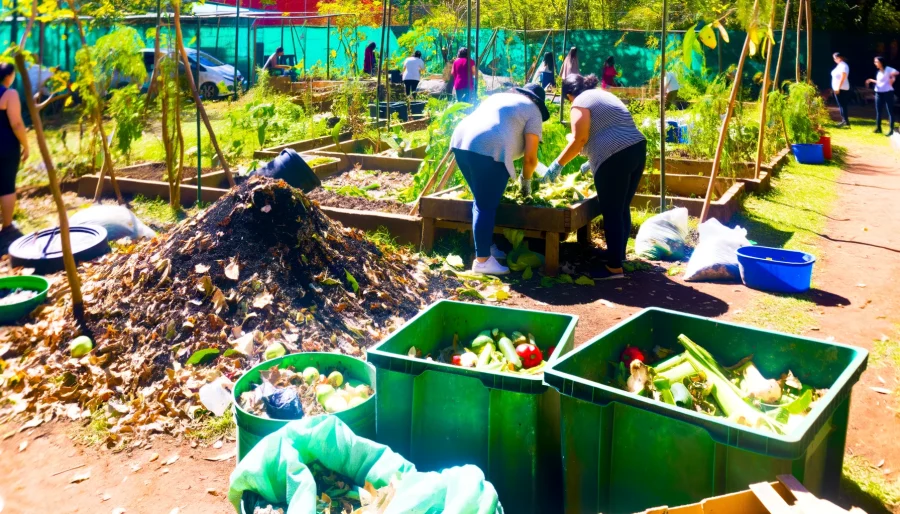
Composting:
Teach the basics of composting, including how to start a compost pile, what materials to use, and how to maintain it. Composting is a valuable skill for sustainable gardening.
Water Conservation:
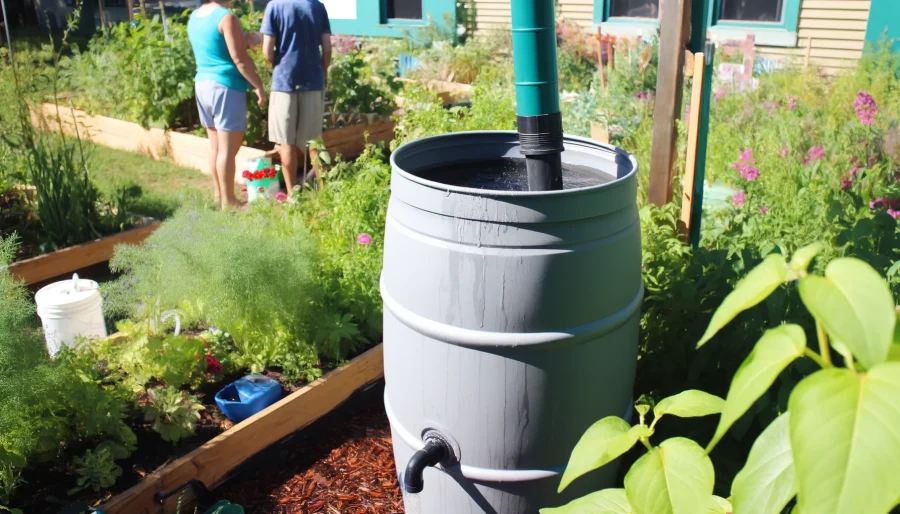
Discuss methods to conserve water in the garden, such as drip irrigation, rainwater harvesting, and mulching. These practices help protect valuable water resources.
Native Plants and Pollinators:
Highlight the importance of planting native species and creating habitats for pollinators like bees and butterflies. This can help support local biodiversity and ecosystem health.
Community Building and Engagement
Garden Tours:
Organize tours of successful community gardens in your area. These tours can inspire participants, share best practices, and foster connections between different gardening groups.
Harvest Festivals:
Celebrate the harvest season with a festival featuring fresh produce, local crafts, and family-friendly activities. This can bring the community together and showcase the benefits of community gardening.
Seed Swaps:
Host a seed swap event where gardeners can exchange seeds, share gardening tips, and discover new plant varieties.
This promotes biodiversity and strengthens community bonds.
Family and Youth Activities
Kids’ Gardening Workshops:
Offer fun and educational workshops for children, such as planting seeds, creating garden art, or building insect hotels.
Engaging kids in gardening helps foster a love for nature.
Family Gardening Days:
Organize events where families can garden together. Activities might include planting, weeding, and learning about plants.
These days can create lasting memories and encourage family bonding.
Skill Sharing and Collaboration
DIY Garden Projects:
Teach participants how to build garden structures like raised beds, compost bins, or trellises.
These hands-on workshops can empower gardeners to enhance their gardens.
Cooking Classes:
Show how to prepare meals using fresh garden produce.
Cooking classes can connect gardening with healthy eating and provide delicious, practical applications for garden harvests.
Organizing educational workshops and community events can greatly enhance the community garden experience.
By offering diverse topics and activities, you can engage gardeners of all ages and skill levels, promote sustainable practices, and strengthen community ties.
Community Garden Workshops and Events
Organizing educational workshops and community events is a great way to engage your gardeners and bring the community together.
Let’s look at how to set up these activities and explore some exciting topics and events to consider.
Organizing Educational Workshops and Community Events
Planning and Preparation
Identify Interests and Needs:
Survey your community to find out what topics they are interested in and what skills they want to learn.
This helps ensure that your workshops and events are relevant and well-attended.
Set Clear Objectives:
Define what you want to achieve with each workshop or event.
Whether it’s teaching new skills, promoting sustainability, or fostering community spirit, having clear goals will guide your planning process.
Choose the Right Time and Place:
Schedule events at times that are convenient for most people, such as weekends or evenings.
Ensure the location is accessible and has the necessary facilities for your activities.
Find Experts and Speakers:
Invite local experts, master gardeners, or experienced community members to lead workshops.
Their knowledge and experience can provide valuable insights and make the events more engaging.
Promotion and Outreach
Use Multiple Channels:
Promote your workshops and events through social media, community bulletin boards, newsletters, and word of mouth.
The more channels you use, the wider your reach will be.
Create Eye-Catching Materials:
Design attractive flyers and posters that highlight the key details of your events.
Use images and clear, concise text to draw attention and provide essential information.
Engage with the Community:
Encourage community members to spread the word and invite their friends and family.
Personal invitations and enthusiastic recommendations can significantly boost attendance.
Topics and Activities to Engage Gardeners and the Community
Gardening Skills and Techniques
Basic Gardening:
Host workshops on fundamental gardening skills like soil preparation, planting, and watering.
These sessions are great for beginners looking to get started.
Advanced Techniques:
Offer advanced workshops on topics like grafting, hydroponics, or organic pest control.
These can attract more experienced gardeners seeking to deepen their knowledge.
Seasonal Gardening:
Organize sessions that focus on gardening tasks for each season, such as planting in spring, maintaining crops in summer, and preparing the garden for winter.
Sustainability and Environmental Awareness
Composting:
Teach the basics of composting, including how to start a compost pile, what materials to use, and how to maintain it.
Composting is a valuable skill for sustainable gardening.
Water Conservation:
Discuss methods to conserve water in the garden, such as drip irrigation, rainwater harvesting, and mulching.
These practices help protect valuable water resources.
Native Plants and Pollinators:
Highlight the importance of planting native species and creating habitats for pollinators like bees and butterflies.
This can help support local biodiversity and ecosystem health.
Community Building and Engagement
Garden Tours:
Organize tours of successful community gardens in your area.
These tours can inspire participants, share best practices, and foster connections between different gardening groups.
Harvest Festivals:
Celebrate the harvest season with a festival featuring fresh produce, local crafts, and family-friendly activities.
This can bring the community together and showcase the benefits of community gardening.
Seed Swaps:
Host a seed swap event where gardeners can exchange seeds, share gardening tips, and discover new plant varieties.
This promotes biodiversity and strengthens community bonds.
Family and Youth Activities
Kids’ Gardening Workshops:
Offer fun and educational workshops for children, such as planting seeds, creating garden art, or building insect hotels.
Engaging kids in gardening helps foster a love for nature.
Family Gardening Days:
Organize events where families can garden together. Activities might include planting, weeding, and learning about plants.
These days can create lasting memories and encourage family bonding.
Skill Sharing and Collaboration
DIY Garden Projects:
Teach participants how to build garden structures like raised beds, compost bins, or trellises. These hands-on workshops can empower gardeners to enhance their gardens.
Cooking Classes:
Show how to prepare meals using fresh garden produce. Cooking classes can connect gardening with healthy eating and provide delicious, practical applications for garden harvests.
Organizing educational workshops and community events can greatly enhance the community garden experience.
By offering diverse topics and activities, you can engage gardeners of all ages and skill levels, promote sustainable practices, and strengthen community ties.
Urban Community Garden Case Studies
Urban community gardens have transformed city spaces into thriving green oases.
Let’s look at some successful examples and the lessons learned from these inspiring projects.
Examples of Successful Community Gardens in Urban Areas
1. The Battery Urban Farm, New York City
Overview:
Located in the Battery, one of New York City’s oldest public parks, this urban farm was established to educate students about urban agriculture. The farm grows a variety of vegetables, herbs, and flowers, engaging over 5,000 students annually.
Key Features:
- Educational Programs: Offers hands-on learning experiences for schoolchildren, teaching them about sustainable farming and healthy eating.
- Community Involvement: Involves volunteers from the community to help maintain the garden.
- Diverse Crops: Cultivates a wide range of plants, promoting biodiversity.
2. P-Patch Community Gardens, Seattle
Overview:
Seattle’s P-Patch program includes over 90 community gardens spread throughout the city.
Established in 1973, the program aims to create green spaces that foster community engagement and sustainable practices.
Key Features:
- Accessibility: Gardens are designed to be accessible to people of all ages and abilities.
- Community Building: Provides spaces for neighborhood events, workshops, and social gatherings.
- Sustainability: Focuses on organic gardening practices and water conservation.
3. La Finca del Sur, The Bronx, New York City
Overview:
This community farm, founded by Latina and Black women, focuses on food justice and community empowerment.
It provides fresh produce to a historically underserved community while promoting cultural heritage.
Key Features:
- Empowerment: Aims to empower women of color through urban farming.
- Cultural Significance: Grows culturally relevant crops, reflecting the community’s heritage.
- Food Access: Increases access to fresh, healthy food in a food desert.
4. South Central Farm, Los Angeles
Overview:
Once the largest urban farm in the U.S., South Central Farm was a 14-acre community garden in South Los Angeles.
Although it was controversially closed in 2006, it remains a powerful symbol of urban farming and community resilience.
Key Features:
- Community Mobilization: Demonstrated the power of community activism and grassroots organizing.
- Sustainable Practices: Used organic farming methods and promoted environmental stewardship.
- Social Impact: Provided food security and green space in a densely populated urban area.
Lessons Learned and Best Practices from These Projects
Community Engagement
Inclusivity:
Successful gardens engage a diverse group of community members, including different ages, backgrounds, and abilities.
Inclusivity fosters a sense of ownership and pride among participants.
Education:
Providing educational programs helps spread knowledge about sustainable practices and healthy eating.
Workshops, school partnerships, and hands-on learning opportunities can enhance community involvement.
Sustainable Practices
Organic Gardening:
Using organic methods minimizes environmental impact and promotes soil health.
Avoiding synthetic chemicals protects local ecosystems and ensures safer, healthier produce.
Water Conservation:
Implementing water-saving techniques like drip irrigation, rainwater harvesting, and mulching helps conserve water and reduce garden maintenance costs.
Planning and Management
Clear Organization:
Establishing committees and defining roles can help manage the garden effectively.
Regular meetings and clear communication keep everyone informed and involved.
Funding and Support:
Securing diverse funding sources, including grants, donations, and fundraising events, ensures financial stability.
Building partnerships with local businesses and organizations can provide additional resources and support.
Social Impact
Food Security:
Urban gardens can play a crucial role in addressing food deserts and providing fresh produce to underserved communities.
Prioritizing food access and affordability can have significant social benefits.
Community Building:
Gardens serve as communal spaces where people can gather, share experiences, and build relationships.
Hosting events and social activities strengthens community bonds.
Urban community gardens offer numerous benefits, from improving food security to fostering community spirit and promoting sustainability.
By learning from successful examples and adopting best practices, new projects can thrive and make a meaningful impact on their urban environments.
Community Garden Networking and Resources
Building a network with other gardens and organizations can enhance your community garden’s success.
Let’s explore how to create these connections and utilize available resources and support networks.
Building Connections with Other Gardens and Organizations
Join Local Garden Networks
Community Garden Associations:
Many cities have community garden associations that provide support, resources, and networking opportunities.
Joining these groups can connect you with other local gardens and share best practices.
Local Gardening Clubs:
Participate in local gardening clubs to meet fellow gardeners and learn from their experiences.
These clubs often host events, workshops, and tours that can provide valuable insights.
Neighborhood Coalitions:
Engage with neighborhood coalitions or community councils.
These groups often have established connections and can help promote your garden and its events.
Partner with Organizations
Non-Profit Organizations:
Partner with non-profits focused on urban agriculture, environmental sustainability, or food security.
These organizations can offer grants, volunteer support, and educational resources.
Schools and Universities:
Collaborate with local schools and universities for educational programs and research projects.
This can provide mutual benefits, such as access to student volunteers and expertise from academic staff.
Businesses and Corporations:
Reach out to local businesses and corporations for sponsorships, donations, or volunteer support.
Many companies have corporate social responsibility programs that support community initiatives.
Use Online Platforms
Social Media Groups:
Join social media groups and forums dedicated to community gardening.
Platforms like Facebook, Reddit, and Nextdoor can connect you with a broader community and provide a space to share ideas and resources.
Online Directories:
Register your garden with online directories like the American Community Gardening Association’s garden map.
This increases visibility and can attract volunteers, donors, and collaborators.
Utilizing Available Resources and Support Networks
Grants and Funding
Government Grants:
Apply for local, state, or federal grants dedicated to urban agriculture and community development.
Resources like the USDA and local agricultural extensions can provide funding opportunities.
Foundation Grants:
Many foundations offer grants for community projects. Research foundations that focus on gardening, sustainability, and community health to find suitable funding options.
Crowdfunding:
Use crowdfunding platforms like GoFundMe or Kickstarter to raise funds for specific projects or needs.
Engage your community by sharing your campaign widely.
Educational Resources
Workshops and Training:
Attend workshops and training sessions offered by local agricultural extensions, botanical gardens, or non-profits.
These sessions can enhance your gardening knowledge and skills.
Gardening Books and Online Courses:
Invest in gardening books or enroll in online courses that cover various aspects of community gardening.
These resources can provide in-depth information and practical tips.
Volunteer and Support Networks
Volunteer Recruitment:
Utilize platforms like VolunteerMatch to find volunteers interested in gardening and community projects.
Create engaging volunteer opportunities and promote them through multiple channels.
Mentorship Programs:
Seek out mentorship programs where experienced gardeners can provide guidance and support.
Learning from seasoned gardeners can help you avoid common pitfalls and improve your garden’s success.
Sharing Resources
Tool Libraries:
Join or create a tool library where community members can borrow gardening tools.
This reduces costs and ensures that everyone has access to the equipment they need.
Seed Exchanges:
Participate in or organize seed exchanges to share seeds with other gardeners.
This promotes biodiversity and allows gardeners to try new plant varieties.
Building connections with other gardens and organizations and utilizing available resources can significantly enhance the success of your community garden.
By fostering these relationships and tapping into support networks, you can create a thriving, sustainable garden that benefits the entire community.
Addressing Food Insecurity through Community Gardens
Community gardens can play a significant role in alleviating food deserts and providing fresh produce to those in need.
Let’s explore how these gardens can combat food insecurity and effective strategies for distributing produce.
How Community Gardens Can Alleviate Food Deserts
Improving Access to Fresh Produce
Local Food Production:
Community gardens create a local source of fresh fruits and vegetables, reducing the distance food must travel to reach urban areas.
This means fresher, more nutritious produce is available to community members.
Affordable Produce:
Gardening reduces the cost of food. Community members can grow their own produce at little to no cost, making healthy food more affordable.
Surplus produce can be distributed to those in need, further alleviating food insecurity.
Building Food Security
Educational Opportunities:
Gardening programs can teach community members how to grow their own food, increasing self-sufficiency.
Educational workshops on gardening, nutrition, and cooking can empower people to make healthier food choices.
Community Engagement:
Gardens bring people together to work towards a common goal.
This strengthens community bonds and fosters a sense of shared responsibility for food security.
Working together, communities can better advocate for resources and support to address food deserts.
Environmental Benefits
Sustainable Practices:
Community gardens often employ sustainable practices such as composting, organic farming, and water conservation.
These methods promote long-term environmental health and can be models for larger agricultural practices.
Biodiversity:
Gardens promote biodiversity by growing a variety of plants.
This not only benefits the environment but also increases the variety of nutrients available in the community’s diet.
Strategies for Distributing Produce to Those in Need
Direct Distribution
Food Pantries and Soup Kitchens:
Partner with local food pantries and soup kitchens to donate surplus produce. This ensures that fresh, healthy food reaches those who need it most.
Produce Stands:
Set up produce stands in accessible locations where community members can purchase or take fresh produce at reduced prices or for free.
These stands can be a regular feature or pop up during harvest times.
Community Programs
Community Supported Agriculture (CSA):
Implement a CSA program where community members can subscribe to receive regular shares of the garden’s produce.
Offer sliding scale pricing or donation-based shares to ensure accessibility for low-income families.
Meal Programs:
Collaborate with local schools, senior centers, and community organizations to incorporate garden produce into meal programs.
This can improve the nutritional quality of meals served to vulnerable populations.
Educational Initiatives
Cooking Classes:
Host cooking classes that teach community members how to prepare meals using garden produce.
This helps people make the most of the fresh food available and encourages healthy eating habits.
Nutrition Workshops:
Offer workshops on nutrition and the benefits of fresh produce.
Educating the community about the importance of a healthy diet can increase the demand for fresh fruits and vegetables.
Partnerships and Collaborations
Local Businesses:
Partner with local grocery stores and restaurants to distribute excess produce.
Businesses can help with storage, transportation, and distribution logistics.
Non-Profit Organizations:
Work with non-profits focused on food security to reach a broader audience.
These organizations often have the infrastructure and experience to effectively distribute food to those in need.
Food Preservation
Canning and Preserving Workshops:
Teach community members how to can, freeze, and dry produce.
This extends the shelf life of garden produce and ensures a steady supply of food throughout the year.
Community Kitchens:
Set up community kitchens where surplus produce can be processed and preserved.
These kitchens can also serve as educational spaces for teaching food preservation techniques.
Community gardens are a powerful tool in addressing food insecurity and alleviating food deserts.
By improving access to fresh produce, fostering community engagement, and employing effective distribution strategies, gardens can significantly enhance food security for urban communities.
Empowering Marginalized Groups through Community Gardens
Community gardens are more than just places to grow food; they can also be powerful tools for promoting diversity, inclusion, and leadership among marginalized groups.
Let’s explore how to encourage these values in community gardening and provide leadership opportunities for underrepresented individuals.
Encouraging Diversity and Inclusion in Community Gardening Benefits
Inclusive Outreach and Engagement
Targeted Outreach:
Reach out to marginalized communities directly through local organizations, cultural centers, and social media platforms.
Tailor your messaging to resonate with different cultural and social groups.
Multilingual Resources:
Provide gardening information and resources in multiple languages to ensure that non-English speakers can fully participate and understand the activities and benefits of the garden.
Cultural Sensitivity:
Be mindful of cultural practices and preferences when planning garden activities.
For example, grow culturally significant crops and celebrate diverse cultural festivals within the garden.
Creating a Welcoming Environment
Inclusive Design:
Design the garden to be accessible to people of all abilities.
This includes wide pathways for wheelchairs, raised beds for those who have difficulty bending, and seating areas for rest.
Community Events:
Host events that celebrate the diversity of the community, such as potluck dinners featuring dishes from different cultures, or cultural heritage days that highlight traditional gardening practices.
Safe Spaces:
Ensure the garden is a safe and welcoming space for everyone. Establish clear policies against discrimination and harassment, and create a committee to address any issues that arise.
Providing Leadership Opportunities for Underrepresented Groups
Leadership Development Programs
Training and Mentorship:
Offer leadership training and mentorship programs for underrepresented groups.
Provide workshops on project management, public speaking, and community organizing to empower individuals to take on leadership roles.
Peer Mentoring:
Encourage experienced gardeners from marginalized groups to mentor newcomers.
This peer support can build confidence and foster a sense of belonging and community.
Representation in Governance
Inclusive Committees:
Ensure that the garden’s leadership and decision-making bodies reflect the diversity of the community.
This might involve creating reserved seats for representatives from marginalized groups.
Community Input:
Regularly seek input from all community members on garden policies, events, and activities.
Use surveys, focus groups, and open meetings to gather diverse perspectives and ensure that everyone’s voice is heard.
Recognizing and Celebrating Contributions
Volunteer Recognition:
Acknowledge and celebrate the contributions of volunteers from marginalized groups.
This can be through awards, public recognition at events, or features in garden newsletters and social media.
Success Stories:
Share stories of individuals from underrepresented groups who have taken on leadership roles and made significant contributions to the garden.
Highlighting these successes can inspire others and demonstrate the impact of diversity and inclusion.
Partnerships and Collaborations
Local Organizations:
Collaborate with organizations that support marginalized groups, such as advocacy groups, cultural associations, and social service agencies.
These partnerships can provide additional resources and support for your garden.
Educational Institutions:
Partner with schools, colleges, and universities to offer internships and volunteer opportunities that focus on community leadership and engagement.
These partnerships can provide valuable experience and exposure for students from diverse backgrounds.
Empowering marginalized groups through community gardens involves creating inclusive spaces, providing leadership opportunities, and celebrating the contributions of all community members.
By fostering diversity and inclusion, community gardens can become vibrant hubs of social change and empowerment.
Community Gardens Benefits Resource Section
Here are some resources to support your community garden initiatives, offering valuable information on a variety of topics related to community gardening.
General Community Gardening Resources
- American Community Gardening Association (ACGA)
- ACGA provides resources and networking opportunities for community gardens across North America. They offer guides, webinars, and a national conference to support community gardeners.
- National Gardening Association (NGA)
- NGA offers a wealth of information on gardening techniques, plant databases, and educational resources. Their site includes articles, how-to guides, and forums for gardeners of all levels.
Organic Gardening Techniques
- Organic Gardening by Rodale Institute
- Rodale Institute is a leader in organic farming research and education. Their website offers extensive resources on organic gardening practices, including composting, soil health, and pest management.
- The Organic Gardener’s Handbook of Natural Pest and Disease Control
- Available on Amazon, this comprehensive guide provides organic solutions for common garden problems.

- Available on Amazon, this comprehensive guide provides organic solutions for common garden problems.
Composting and Sustainability
- EPA Composting Basics
- The Environmental Protection Agency (EPA) provides an excellent guide on composting at home, detailing the benefits, methods, and maintenance of compost piles and bins.
- Composting for Beginners by Cornell Waste Management Institute
- Cornell University offers a detailed guide on starting and maintaining a compost system, tailored for beginners.
Water Conservation
- WaterSense by the U.S. Environmental Protection Agency
- WaterSense provides resources on water-efficient gardening and landscaping practices, including tips on irrigation and rainwater harvesting.
- Garden Watering Tips by the National Wildlife Federation
- The NWF offers practical advice on conserving water in your garden, promoting sustainability and efficient water use.
Community Engagement and Education
- KidsGardening.org
- KidsGardening offers educational resources, activity ideas, and grant opportunities to engage children in gardening. Their site includes lesson plans, project guides, and success stories from youth gardens.
- School Garden Resources by Life Lab
- Life Lab provides a wealth of resources for school gardens, including curriculum guides, training workshops, and research on the benefits of garden-based education.
Food Security and Urban Agriculture
- Food Security by the Food and Agriculture Organization (FAO)
- The FAO offers global insights and resources on food security, including best practices for urban agriculture and community gardening to combat food deserts.
- Urban Agriculture by the RUAF Foundation
- RUAF provides resources and case studies on urban agriculture and city farming, focusing on sustainable food production and community empowerment.
Networking and Support
- American Horticultural Society (AHS)
- The AHS connects gardeners across the U.S. and offers resources on gardening practices, plant care, and community engagement. They host events and provide educational materials for gardeners of all experience levels.
- Extension Master Gardener Program
- Managed by the Cooperative Extension System, this program offers training and resources through local extension offices. Master Gardeners provide volunteer support and expertise to community gardening projects.
These resources offer a comprehensive foundation for anyone involved in community gardening, from beginners to experienced gardeners.
They provide practical advice, educational materials, and support networks to help your garden thrive.
Related Content
Visit my Amazon Influencer Page for videos and gardening products Grow Your Own Garden


